Inside The New York Botanical Garden
The Edible Garden
Posted in Exhibitions, The Edible Garden on August 27 2010, by Plant Talk
Cooking Demo to Showcase these Pinky-sized Jewels in Caponata
 |
Rebecca Lando is writer, producer, and host of the Web series Working Class Foodies. She will present cooking demonstration along with Chef Brendan McDermott at The Edible Garden Conservatory Kitchen on Saturday, August 28, at 1 and 3 p.m. |
Eggplant is kind of the middle child of the summer farmer’s market.
Inedible raw unlike tomatoes, peppers, and cucumbers, and more complex to prepare than grilled or boiled corn, eggplant seems to stand out for all the wrong reasons: its dense flesh and generally heavy preparation can make it a bit of an overlooked anomaly. The time and degree of cooking generally necessary for eggplant makes it an awkward summer crop, seemingly out of place when you’re craving a light, refreshing dinner.
My mother used to halve and hollow large eggplants, stuff them with a sauteed mix of ground lamb, cubed eggplant flesh, onion, olives, and spices, top them with cheese, and broil them until the cheese was bubbly and the eggplant skin was crispy. Delicious and filling, but it would be torturous to eat in summer. Likewise, eggplant parmesan is too heavy for the hot months, and even a cooling baba ghanouj means turning on the oven.
But eggplant is far more versatile than you might think. Sliced thick and rubbed with a paste of olive oil, sea salt, crushed hot pepper, oregano, and lemon juice, then thrown on the grill, it’s a hearty and healthy alternative to steak. Cooked the same way and then cut down into cubes, it’s a fantastic base for a rustic Provencal ratatouille.
Read More
Posted in Exhibitions, Learning Experiences, The Edible Garden on August 26 2010, by Plant Talk
9-Year-Old Everett Sanderson Offers 9 Tips to Get Growing
 |
Elizabeth Fisher is Associate Manager for Education Marketing and Public Relations. |
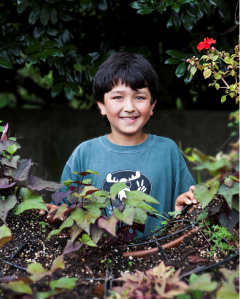 Everett Sanderson is a talented soon-to-be fifth grader who has spent most of his nine summers gardening in the Ruth Rea Howell Family Garden, helping his mom, Han-Yu Hung, who is Garden Coordinator of the Children’s Gardening Program. In the Family Garden, kids work hands-on growing fruits and vegetables, learning that food, fun, health, and teamwork are connected. This year their garden plots have been in the spotlight as part of The Edible Garden.
Everett Sanderson is a talented soon-to-be fifth grader who has spent most of his nine summers gardening in the Ruth Rea Howell Family Garden, helping his mom, Han-Yu Hung, who is Garden Coordinator of the Children’s Gardening Program. In the Family Garden, kids work hands-on growing fruits and vegetables, learning that food, fun, health, and teamwork are connected. This year their garden plots have been in the spotlight as part of The Edible Garden.
Unlike most 9-year-olds, Everett is an accomplished gardener and a lover of veggies. Harvesting is what hooked him at first: “I realized that in order to harvest, you have to grow it, and in order to grow it, you have to plant it,” said Everett. Gardening also helped him to love eating vegetables: “If you can plant it, you have a better chance of liking it.”
Now a veteran of the Children’s Gardening Program, Everett, who lives in the Bronx, started gardening at age 3 as a “Garden Sprout” and is now a “Garden Crafter,” leading gardening lessons and hands-on activities.
He shares these helpful tips for kids to get their own gardens growing.
Read More
Posted in Exhibitions, The Edible Garden on August 20 2010, by Plant Talk
From Traumatic Childhood Episode to Experimental Dishes
 |
Pichet Ong is chef and owner of P*ong and Village Tart, and author of The Sweet Spot. He will present cooking demonstrations at The Edible Garden Conservatory Kitchen on Sunday, August 22, at 1 and 3 p.m. |
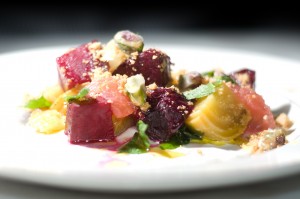 I was born an adventurous eater. While the lunchboxes of my elementary school mates were filled with aluminum-wrapped peanut butter and jelly, ham and cheese, and egg salad sandwiches, mine often had well seasoned leftovers from our previous night’s family dinner—duck liver and minced quail stir-fry, bitter melon soup, twice-cooked pork belly, or potato vinaigrette with Sichuan peppercorns.
I was born an adventurous eater. While the lunchboxes of my elementary school mates were filled with aluminum-wrapped peanut butter and jelly, ham and cheese, and egg salad sandwiches, mine often had well seasoned leftovers from our previous night’s family dinner—duck liver and minced quail stir-fry, bitter melon soup, twice-cooked pork belly, or potato vinaigrette with Sichuan peppercorns.
I remember the first time I had beets; my mother, Ruby, warned me: It’s not like eating a red plum, steak tartare, or raw tuna. She also promised me, like with all red foods, including watermelon, that it is good for the blood.
My first taste of beets came in the form of a borscht—a traditional Eastern European soup that made its way into modern Chinese cuisine due to the Chinese’s obsession with red-colored food. Inspired by the Hong Kong-style borscht, which is beef- stocked based with tomatoes, ketchup, and red vinegar (which has food dye), and last night’s leftover vegetables thrown in, my mother came up with an all-natural version that incorporates beetroots in lieu of artificial color in the recipe. More vibrant in fuchsia and red tones, and tastier than the ubiquitous version found in restaurants, despite my mother’s warning, I helped myself to seconds at the dinner table, and even packed up some for my lunch the next day. The next morning when I went to the boy’s room, I understood—explicitly—my mother’s warning. I left for school queasy, confused, and mellow—sans borscht.
Read More
Posted in Exhibitions, The Edible Garden on August 18 2010, by Plant Talk
How Hot Can You Tolerate? Visit Trial Bed in Home Gardening Center
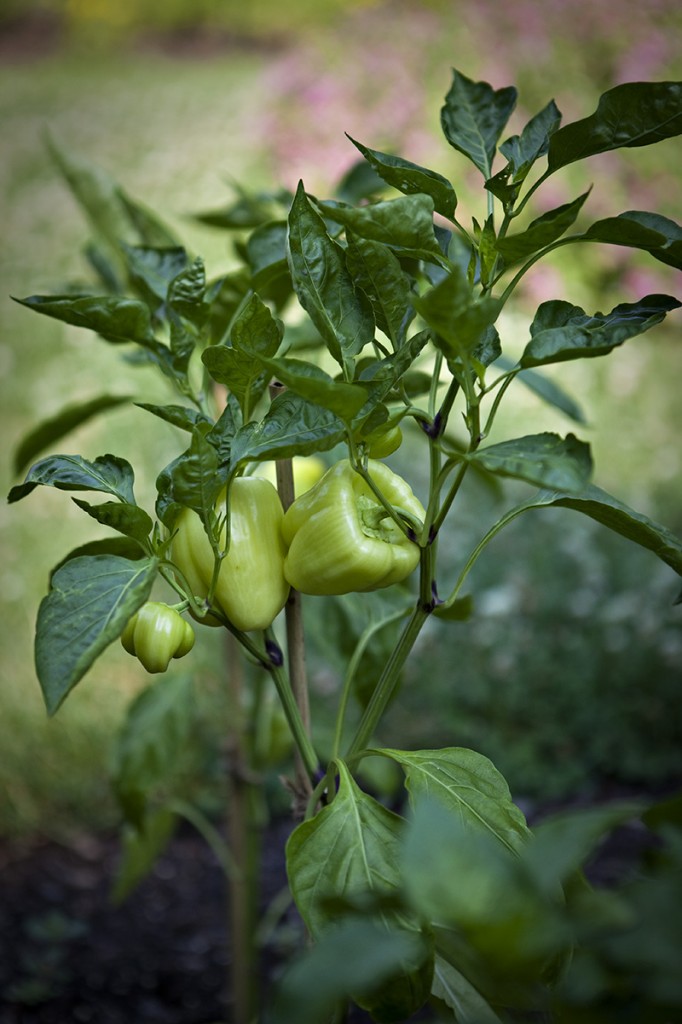 Some might say this summer’s weather has been hotter than a chili pepper. But there are some really intense chili peppers out there! During The Edible Garden, the Home Gardening Center is featuring a Chili Pepper Trial Bed, highlighting 48 plants of 12 cultivars in a range of colors, sizes, and heat intensity.
Some might say this summer’s weather has been hotter than a chili pepper. But there are some really intense chili peppers out there! During The Edible Garden, the Home Gardening Center is featuring a Chili Pepper Trial Bed, highlighting 48 plants of 12 cultivars in a range of colors, sizes, and heat intensity.
The chili pepper is thought to be the most popular spice: Over 20 percent of the world’s population uses it in some form. Famous for a hot flavor, there are many different cultivated types, each with distinct characteristics.
The term chili pepper is used for several of the nearly 25 species in the genus Capsicum, all of which originated in Central and South America. The two most common species are Capsicum annuum and Capsicum frutescens.
The level of the pungent compound capsaicin is what accounts for the pungency or heat in chilies. Some peppers are so pungent that farmers and cooks need to wear gloves to protect their skin, which can become irritated or blistered just by touching the peppers.
The hotness of a chili pepper is measured in Scoville Heat Units, named after the U.S. pharmacologist Wilbur Scoville who in 1912 invented a hotness gauge. On the Scoville scale, a sweet pepper scores 0, a jalapeño pepper around 3,000, and a Mexican habañero a scorching 500,000.
The Chili Pepper Trial Bed is arranged according to the Scoville scale and includes Capsicum chinese ‘Bhut Jolokia’ from India, which registers over 1 million Scoville units! Labels in the garden indicate how hot each pepper is.
Come visit the trial bed and The Edible Garden to get ideas on which types you’d like to try—in your garden and in your cooking. On Saturday, September 25, we’ll present a home gardening demonstration on chili peppers, Some Like It Hot, as part of the Fiesta de Flores y Comida festival weekend, celebrating Hispanic Heritage Month with flowers, food, dancing, cooking demonstrations (with Chef Maricel Presilla and others), and more.
Get Your Tickets
Posted in Exhibitions, The Edible Garden on August 13 2010, by Plant Talk
Anything Goes—and Grows—in Potting Up Vegetables for Small Spaces
 |
Francisca Coelho is the Vivian and Edward Merrin Associate Vice President for Glasshouses and Exhibitions. |
 You may not be aware of this, but every plant you have grown in a pot, box, can, tub, or other vessel is an example of container gardening. Your potted houseplants, summer pots of annuals, and hanging baskets all represent gardening in containers. In the tropics where I grew up, people lined their front steps with many colorful, painted containers of every shape and size. They filled them with beautiful, tropical, flowering exotics and with plants used for food and medicine. Versatility is the hallmark of the container gardener!
You may not be aware of this, but every plant you have grown in a pot, box, can, tub, or other vessel is an example of container gardening. Your potted houseplants, summer pots of annuals, and hanging baskets all represent gardening in containers. In the tropics where I grew up, people lined their front steps with many colorful, painted containers of every shape and size. They filled them with beautiful, tropical, flowering exotics and with plants used for food and medicine. Versatility is the hallmark of the container gardener!
In front of the Enid A. Haupt Conservatory, as part of The Edible Garden, I am growing an assortment of tasty vegetables in containers. The design is simple-a mix of semicircles and straight lines with pots ranging in size from 14 to 36 inches in diameter.
The steps leading up to the elevated area are lined with pots filled with Tumbling Tom tomatoes, mammoth red cabbages, purple kohlrabi and kale, ornamental trailing sweet potato vines, and marigolds, included to ward off unwelcomed pests and to encourage hungry bees to pollinate my edible delights.
Read More
Posted in Exhibitions, The Edible Garden on August 11 2010, by Plant Talk
What Do These Have to Do with Helping Solve the Climate Crisis?
 |
Anna Lappé is author of Diet for a Hot Planet: The Climate Crisis at the End of Your Fork and What You Can Do About. She will give a talk at the Garden as part of The Edible Garden’s Food for Thought series on August 19 at 7 p.m. |
 A few nights ago, I watched the sky darken over the East River while I listened to clucking chickens peacefully pecking on the roof of a loft in Greenpoint, Brooklyn. Eagle Street Rooftop Farm is just one of the rooftop farms sprouting up across the city, bringing to communities fresh food and the opportunity to get our hands in the dirt.
A few nights ago, I watched the sky darken over the East River while I listened to clucking chickens peacefully pecking on the roof of a loft in Greenpoint, Brooklyn. Eagle Street Rooftop Farm is just one of the rooftop farms sprouting up across the city, bringing to communities fresh food and the opportunity to get our hands in the dirt.
Eagle Street, all 6,000 square feet of it, has only been around two growing seasons, but it already boasts a loyal following. A dozen families are members of its CSA; hundreds of kids have munched on its peppers and tomatoes; and from 40 to 65 volunteers a week have dug in its raised beds. The place is buzzing with life and, the day I was there, newborn rabbits, who earn their keep with droppings used for fertilizer.
Eagle Street is just one of the reasons I’m not feeling so blue these days. In the face of mounting environmental catastrophes—from global climate change to a dead zone in the Gulf of Mexico that swells to the size of New Jersey every year—there’s a lot to feel depressed about. These crises can feel far removed from our daily lives and from our control. But with every choice we make about where get our food, how we support sustainable solutions in our cities, we are helping to heal the climate.
Read More
Posted in Exhibitions, The Edible Garden on August 10 2010, by Plant Talk
Written by Burpee Home Gardens Team. Burpee Home Gardens is a Supporting Sponsor of The Edible Garden.
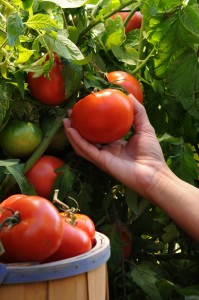 Harvest time is an exciting time in the garden. Those plants you have been taking care of, feeding, weeding, and watering are now returning the favor with ripe pickings for you to enjoy. Very quickly you’ll have a kitchen counter or bushel filled with red and juicy tomatoes, tasty peppers, flavorful cucumbers, and more.
Harvest time is an exciting time in the garden. Those plants you have been taking care of, feeding, weeding, and watering are now returning the favor with ripe pickings for you to enjoy. Very quickly you’ll have a kitchen counter or bushel filled with red and juicy tomatoes, tasty peppers, flavorful cucumbers, and more.
What to do with all this plenty—and when—present some of the last obstacles of the season for new vegetable gardeners. If you’re suddenly inundated with abundance, here are a few tips to remember to receive maximum flavor from your harvest:
Read More
Posted in Exhibitions, The Edible Garden on August 6 2010, by Plant Talk
Presenting Chef Muses on Creating Dishes with Tomatoes
 |
Heather Carlucci-Rodriguez is Pastry Chef at Print Restaurant in Manhattan. She will present cooking demonstrations at The Edible Garden Conservatory Kitchen on August 8 at 1 and 3 p.m. |
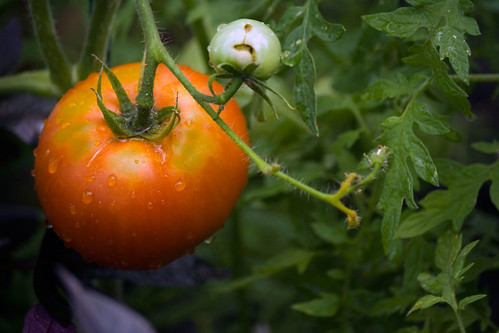 I really don’t think I could have gotten a better item than the tomato (the food selected as the theme of the weekend at The Edible Garden). I’d probably say that about corn if I had been given that as a topic to demo. But honestly, it leaves the whole world open for talk, cooking, pairing, art—you name it.
I really don’t think I could have gotten a better item than the tomato (the food selected as the theme of the weekend at The Edible Garden). I’d probably say that about corn if I had been given that as a topic to demo. But honestly, it leaves the whole world open for talk, cooking, pairing, art—you name it.
I grew up in the neighborhoods around The New York Botanical Garden, and I’m witness to the fact that, lucky for me, the tomato grows bountifully everywhere.
Being a pastry chef, I thought about doing something sweet for my August 8 demo…for about a minute. I am a complete pushover for anything savory with tomatoes. And the tomato is so perfect as it is. Adding sugar, as intriguing as it is, is so unnecessary. Sauces, salads, soups, by itself with a little salt and olive oil…It’s versatile and perfect at this time of year. A must in most of the mother cuisines. The best carrier of the flavor of herbs, vinegars.
Read More
Posted in Exhibitions, The Edible Garden on August 5 2010, by Plant Talk
Spend a Summer Evening with Music, Wine, Cheese, and More
 I always enjoy a great concert in the summer, especially in one of New York City’s fabulous outdoor spaces. There is something just so civilized about hearing great music in exceptional garden surroundings.
I always enjoy a great concert in the summer, especially in one of New York City’s fabulous outdoor spaces. There is something just so civilized about hearing great music in exceptional garden surroundings.
I usually find, however, that I need to bring something to eat and to drink. Well, not at The New York Botanical Garden. We have thought of everything.
During the Waterlily Concert Series at the Garden, which begins this evening and continues on August 12 and 19, Abigail Kirsch is ready to cater to your needs. We are featuring picnic baskets with beer or wine, cheese, crudités, and fruit—a perfect accompaniment to a wonderful summer evening. Other refreshments will be available as well: sandwiches, a variety of snacks, non-alcoholic beverages, and cookies and desserts.
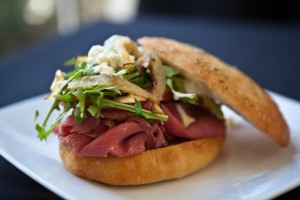 Before each performance, visitors can view The Edible Garden with its Celebrity Chef Kitchen Gardens, Martha Stewart Culinary Herb Garden, and more, and then hear commentary about the importance of food choices in our lives during Food for Thought presentations.
Before each performance, visitors can view The Edible Garden with its Celebrity Chef Kitchen Gardens, Martha Stewart Culinary Herb Garden, and more, and then hear commentary about the importance of food choices in our lives during Food for Thought presentations.
Although seating is provided rain or shine under the tent at the Conservatory Kitchen stage where the lectures and music will be held, I encourage you to bring a blanket to enhance your experience. Stretch out under the sky while enjoying sumptuous fare and listening to fabulous music. There’s no better way to beat the summer heat!
See who’s presenting and performing.
Get Your Tickets
Posted in Exhibitions, The Edible Garden on August 3 2010, by Plant Talk
New Program Features Health Screenings, Cooking Demos, Walking Trails
 |
Sarah Bolson is Associate Director of Foundation Relations. |
Editor’s note: The USDA has proclaimed this week, August 1–7, National Farmers Market Week.
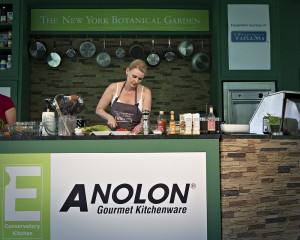 I recently visited the Greenmarket, as I do on most Wednesdays, to pick fresh fruit for the remainder of the work week. In the past, my visits lasted no more than the handful of minutes it took to find whatever items I craved. I left the endless supply of herbs and vegetables—many with names I did not recognize—untouched for a braver and more skilled chef than I can profess to be. But what I found on this particular Wednesday was a deeply enriching experience.
I recently visited the Greenmarket, as I do on most Wednesdays, to pick fresh fruit for the remainder of the work week. In the past, my visits lasted no more than the handful of minutes it took to find whatever items I craved. I left the endless supply of herbs and vegetables—many with names I did not recognize—untouched for a braver and more skilled chef than I can profess to be. But what I found on this particular Wednesday was a deeply enriching experience.
This is because now the Garden’s Greenmarket is about more than simply food. If you visit the market, you will find a host of free activities and programs designed to teach visitors how to lead a heart-healthy lifestyle. The Heart Smart Program, which is supported in part by an American Heart Association New York City Community Impact Grant and the MetLife Foundation, encourages participants to connect the foods they eat to their well-being through activities designed to improve cardiovascular health.
Read More


















